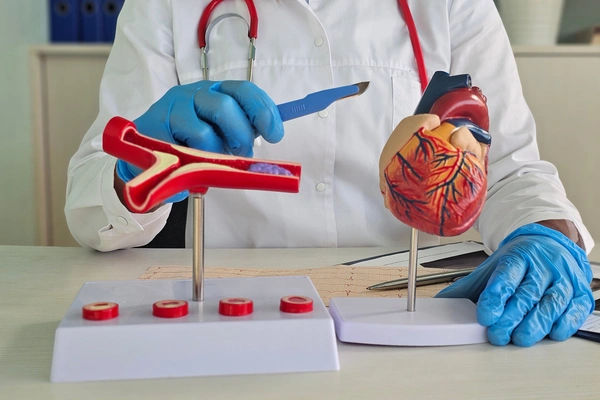- male
- 60 Years
- 22/01/2025
I'm reviewing my angiogram results, and it's making me pretty anxious. It mentions a "20% stenosis" in the distal left main, and a "90% stenosis" in the proximal left anterior descending artery, plus a "60% stenosis" in the mid LAD. The distal LAD is stated as normal, but there's a "40% stenosis" in the diagonal. Also, it says my right coronary artery has a "90% eccentric stenosis" in the distal part, though the rest is fine, as well as the PDA and minimal disease in PLV. Could you help me understand what all this means, and what should be done? I'm feeling really lost here.
Answered by 1 Apollo Doctors
"Based on the findings of your coronary angiogram, it appears that you have significant blockages in your left anterior descending artery (LAD) and right coronary artery (RCA). To address the blockages and improve blood flow to your heart, a treatment plan may include the following: - For the 90% stenosis in the proximal LAD, a coronary artery bypass grafting (CABG) surgery may be recommended. - For the 90% eccentric stenosis in the distal RCA, a percutaneous coronary intervention (PCI) with stent placement could be considered. - Medications such as aspirin, clopidogrel, beta-blockers, ACE inhibitors, and statins may also be prescribed to manage your condition and reduce the risk of further complications. Please consult with your cardiologist to discuss these treatment options and determine the best course of action for your specific case."
Dr. Dhankecha Suggests...
Consult a Cardiologist
Answered 04/07/2025
0
0

More Cardiology Health Queries
View allI've been keeping an eye on my blood pressure lately, and it's been around 140100. I've noticed I'm getting headaches more frequently. Should I be worried about these numbers or the headaches? Is this something I need to get checked out or change in my routine? Any advice would be really helpful.
A blood pressure of 140100 is considered high and can contribute to headaches. I recommend you start taking Amlodipine (brand name Norvasc) 5mg once daily to help lower your blood pressure. Additionally, you can take Acetaminophen (brand name Tylenol) 500mg for your headaches as needed, up to 3 times a day. Remember to monitor your blood pressure regularly and make lifestyle changes such as reducing salt intake and increasing physical activity.
Answered by 1 Apollo Doctors
My dad had bypass surgery about 20 years ago, and now the doctor is suggesting he needs a CAG. They mentioned something about "30 working," and I'm not completely sure what that means. He's 60 years old now. Is it safe for him to go through this procedure again at his age?
"Dear Sir, based on your father's history of bypass surgery and the current recommendation for CAG due to 30% heart function, it is important to proceed with caution. Given his age of 60 years, the procedure can still be safe. Your father may benefit from medications like Clopidogrel 75mg and Atorvastatin 40mg to manage his heart condition. It is important to follow your doctor's advice closely and monitor for any potential complications. Regular follow-up appointments are essential for his ongoing care and management."
Answered by 1 Apollo Doctors
I'm really worried about my mom. Lately, she's been feeling these vibrations in her heart every now and then. It sounds strange, but she tells me it happens occasionally. On top of that, she's also been having leg pain for the past few days. Is this something to be concerned about? She's currently on medications like Ozone cynocal, lcOsil, and Ozone ozocal. Could these symptoms be related to the meds, or is it something else going on? Would really appreciate some guidance.
Your mother's symptoms of occasional heart vibrations, also known as palpitations, and leg pain, could indicate an underlying condition such as arrhythmia, anemia, or poor circulation, and while the medications she's taking, such as Ozone Cynocal LC (iron supplements), Osil Ozone ( omega-3 fatty acids), and Ozocal (calcium supplements), may be helpful, it's essential to consult her doctor urgently to rule out any serious cardiac or vascular issues and adjust her treatment plan accordingly
Answered by 1 Apollo Doctors
Disclaimer: Answers on Apollo 247 are not intended to replace your doctor advice. Always seek help of a professional doctor in case of an medical emergency or ailment.




